This chord lesson is all about the blues. You all know the chord progression for a typical blues, but there are so many variations that it’s hard to know them all. The blues originated in the USA and evolved from African, European and Latin influences. Blues had a very big influence on jazz and nowadays every jazz musician has some blues in his repertoire.
There are many different sets of blues progressions, going from the basic original blues to more modern variations like the changes played by Charlie Parker.
The foundation, however, stays the 12 bar blues with a set of 3 chord changes.
Lesson Contents
Blues Characteristics
Before we dive into the theory behind each of the 6 jazz blues progressions in this lesson, here are some characteristics of the blues:
- Most blues chord progressions are 12 bars long, although there are also 8, 14, 16, 24 or more bar blues changes. There are many different 12 bar blues forms though.
- The tonic chord of a blues is a dominant 7 chord, a fact that doesn’t fit very well in traditional music theory.
- The blues is not only about chord changes and scales, but also about a certain sound. Responsible for that sound are the blue notes (a lowered 3rd note and a lowered 5th note), which you can find in the minor blues scale and major blues scale.
- The 3 basic chords of a blues are all dominant 7 chords.
- There is also a blues form that has minor chords as its foundation, called minor blues.
In the audio files and tabs below, you will hear and see common comping patterns over each of these 12-bar progressions. To keep things practical, the chord voicings on the chart are written as you would see them on a lead sheet, G7, Dm7, Cmaj7, etc.
In a practical comping situation, those chords can be embellished with 9ths, 13ths, 6ths, and other color tones. So, if you hear or see a G13 chord and it’s written as G7, that’s a common approach to comping over lead sheet chords.
Jazz Blues Chord Progressions
In this section, you will learn six different variations of the blues progression.
Basic Blues Chords
The first blues we’ll have a look at is the original 12-bar blues chord progression.
Let’s take a look at how the basic blues changes look from a chord name standpoint:
| Basic Blues (aka I-IV-V Blues) | ||||||
|---|---|---|---|---|---|---|
| F7 | ||||||
| Bb7 | F7 | |||||
| C7 | Bb7 | F7 | ||||
Notice how this simple blues chord progression uses only three chords: the I7, IV7, and V7.
Because of this, they are often referred to as I-IV-V blues chord changes.
Listen to an example of this chord progression in the audio file below.
If you already have a few 7th chords under your fingers, then try jamming along with the changes over the backing track, or on your own at first if you need some practice to get the tempo worked out.
Listen & Play Along
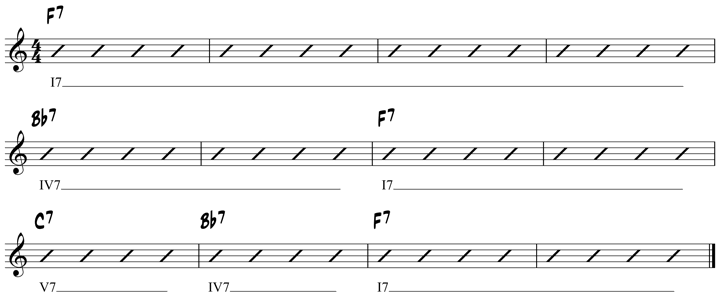
To help you get started with taking these chords onto the fretboard, here is a chord study you can learn and apply to your own playing over the basic blues changes.
To keep things simple, this study is written in a basic riff style, where a short chord riff is played over each change in the progression.
Listen & Play Along
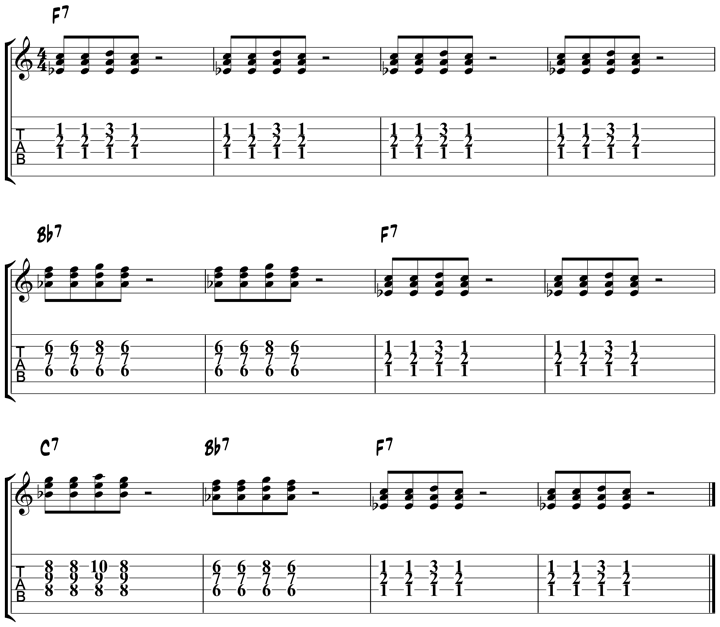
1930s Blues Changes
Moving on to the next blues form, you will now add a IV7 chord in bar 2 of the blues, as well as a II7-V7 turnaround in the last four bars.
Here is how those chords look in the key of F:
| 1930s Blues Changes (aka Quick Change Blues) | ||||||
|---|---|---|---|---|---|---|
| F7 | Bb7 | F7 | ||||
| Bb7 | F7 | |||||
| G7 | C7 | F7 | C7 | |||
Because there is a quick move to the IV7 chord and back to the tonic in the first three bars, this chord progression is often referred to as a quick change blues progression.
To help you get your head around these changes, here is a chart for the blues with the Roman numerals underneath so you can work them in all 12 keys.
Listen & Play Along
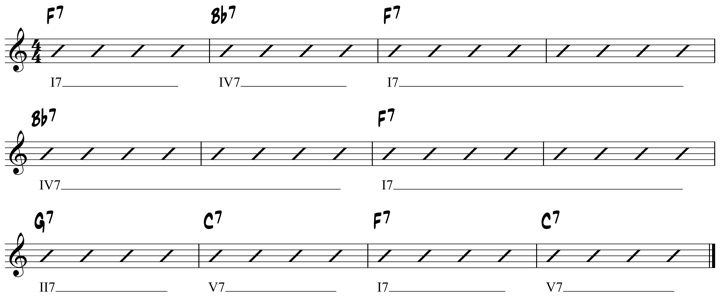
Here is a chord study over a quick-change blues in F progression.
Start by learning the chords on your own slowly, then play along with the given audio, and finally take them to a backing track on your own.
Listen & Play Along
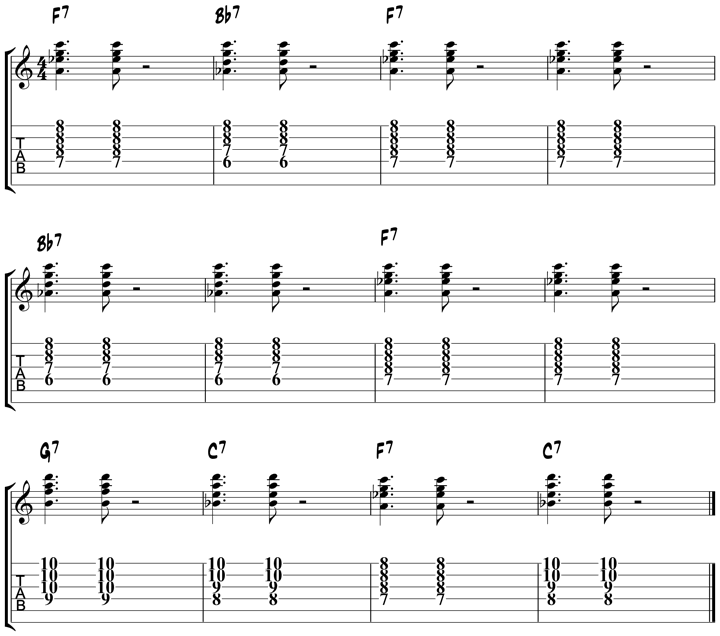
Count Basie Blues
One of the innovations Count Basie brought to the blues, or at least popularized, is the use of the #IVdim7 chord in bars two and six of a jazz blues progression.
You will also see in the examples below that there is a iim7-V7/IV in bar 4 of the tune, as well as a VI7b9 chord in bar 8. These chords that are now commonly used were popularized by the Count Basie Band.
Here is how those changes look in the key of F:
| Count Basie Blues Changes | ||||||
|---|---|---|---|---|---|---|
| F7 | Bb7 Bdim | F7 | Cm7 F7 | |||
| Bb7 | Bdim | F7 | D7b9 | |||
| Gm7 | C7 | F7 | ||||
Notice that the II7 chord from the previous section is now a iim7 chord, constructing a ii-V progression in bars 9 and 10 of the blues, another commonly used change in the modern jazz world.
Here is how those changes sound and look on a lead sheet.
Listen & Play Along
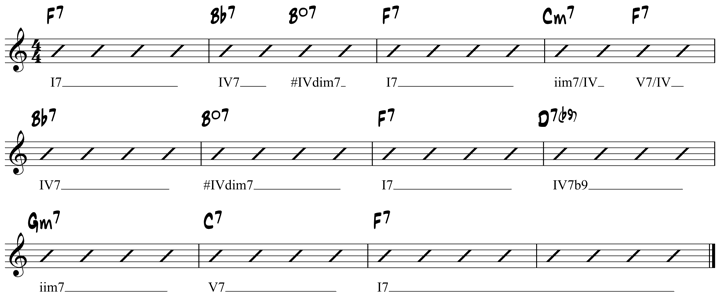
To help you take these changes further in your studies, here is a chord study in the key of F.
Try these chords out with the audio below, and then apply them to other jazz blues jams or practice routines.
Listen & Play Along
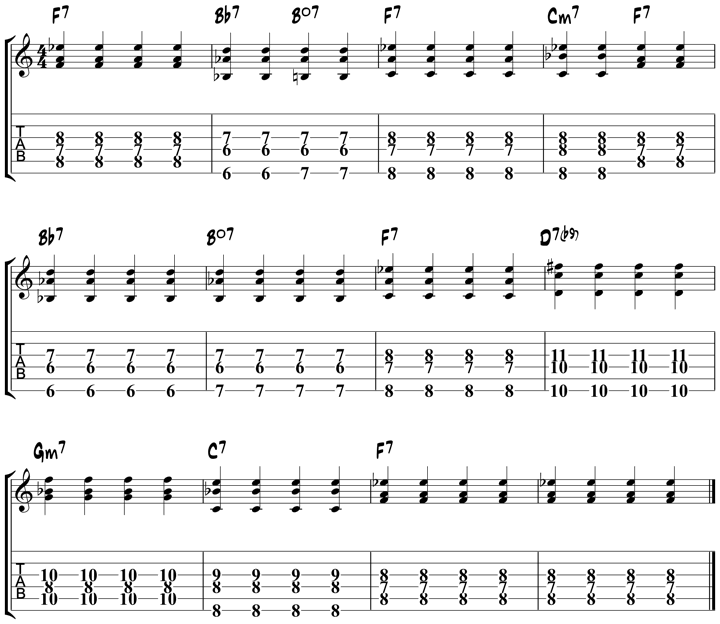
Bebop Blues
Getting into the bebop era with these changes, you will notice 2 things that showcase the bebopper’s love of ii-Vs and fast-moving changes:
- a ii-V of the iim7 chord in bar 8.
- a iii-VI-ii-V progression in the last bar of the tune.
Here is how the bebop blues changes look in the key of F:
| Bebop Blues Changes | ||||||
|---|---|---|---|---|---|---|
| F7 | Bb7 | F7 | Cm7 F7 | |||
| Bb7 | Bdim | F7 | Am7b5 D7b9 | |||
| Gm7 | C7 | Am7 D7 | Gm7 C7 | |||
To get these changes into your ears, here is an audio example and lead sheet for the bebop blues.
Listen & Play Along
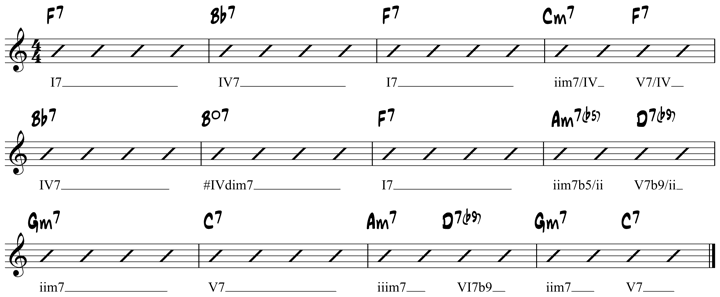
Learn the following chord study in order to begin applying these bebop blues changes to your playing:
Listen & Play Along
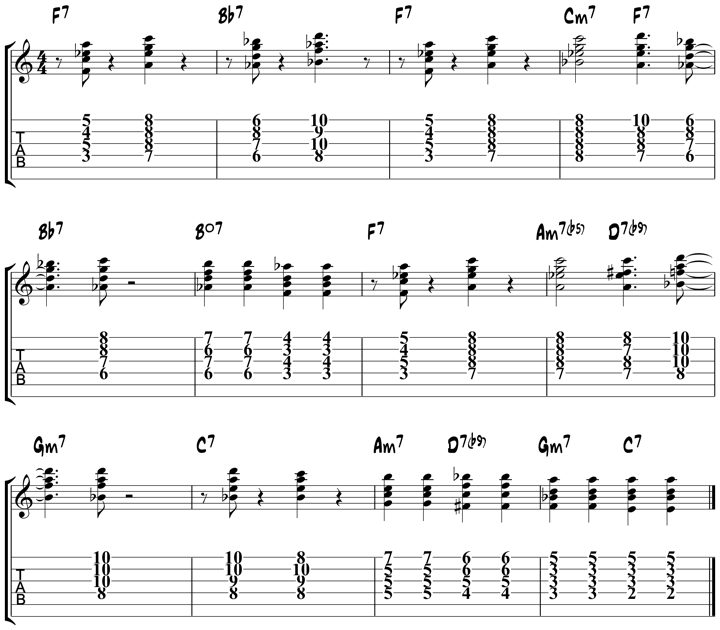
Tritone Substitution Blues
You can also apply tritone substitutions to various bars in the jazz blues progression, as you can see in the following examples:
- Bar 6: the Bb7 is replaced with a tritone ii-V (Bm7-E7).
- Bars 7 and 8: here are four descending dominant 7th chords, with the E7 and Eb7 being used to connect F7 and D7b9 chromatically.
- Bar 10: here is a tritone approach chord added to the Am7, Bb7 in place of E7 (the V7 of Am7).
| Tritone Substitution Blues | ||||||
|---|---|---|---|---|---|---|
| F7 | Bb7 | F7 | Cm7 F7 | |||
| Bb7 | Bm7 E7 | F7 E7 | Eb7 D7b9 | |||
| Gm7 | C7 Bb7 | Am7 D7 | Gm7 C7 | |||
To get this chord substitution under your fingers and into your ears, here is a blues in F using the tritone subs and chromatic 7th chords mentioned above.
Listen & Play Along
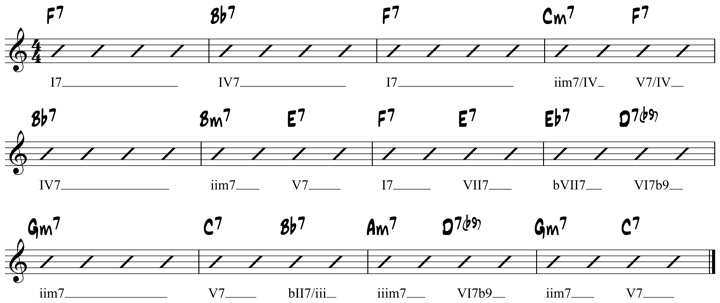
Here is a one-chorus chord study you can learn to take these changes directly to your playing.
Listen & Play Along
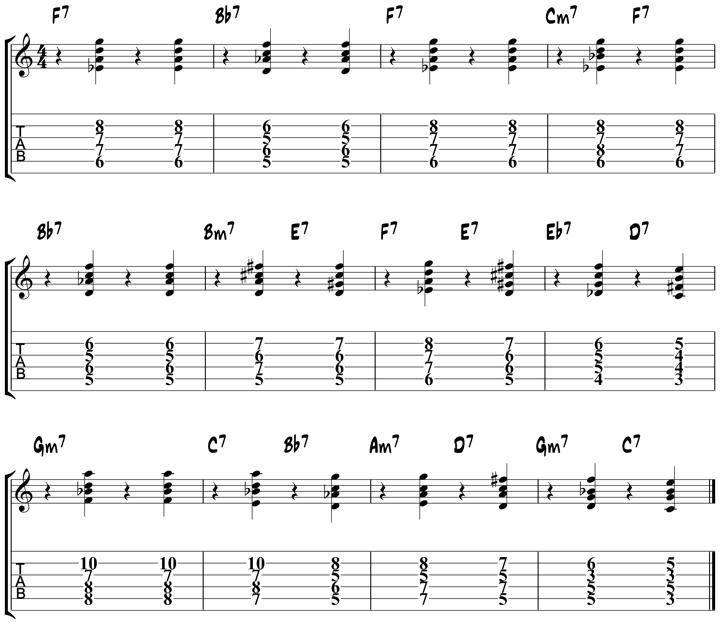
Bird Blues
The last blues progression you’ll look into is named after Charlie Parker and is found in one of his most famous compositions, Blues for Alice.
Reflecting the bebop love of ii-Vs, this progression is full of various ii-V progressions in a number of different keys.
The tune starts and ends with an Fmaj7 chord, which is odd for a blues progression, but it does help to make these changes stand out from the rest of the jazz-blues you will encounter.
Here is how those changes look in the key of F:
| Bird Blues Changes | ||||||
|---|---|---|---|---|---|---|
| Fmaj7 | Em7b5 A7b9 | Dm7 G7 | Cm7 F7 | |||
| Bb7 | Bbm7 Eb7 | Am7 D7 | Abm7 Db7 | |||
| Gm7 | C7 | F D7 | Gm7 C7 | |||
To get these changes into your ears, and understand how they look on paper, here is an audio example and lead sheet for a Bird Blues in F.
Listen & Play Along
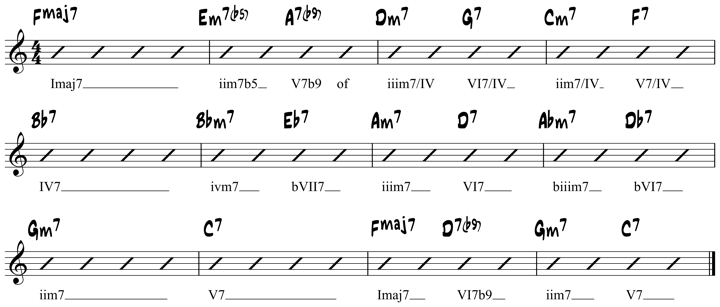
Here is a chord study over a Bird blues in F that you can use to get these chords under your fingers:
Listen & Play Along
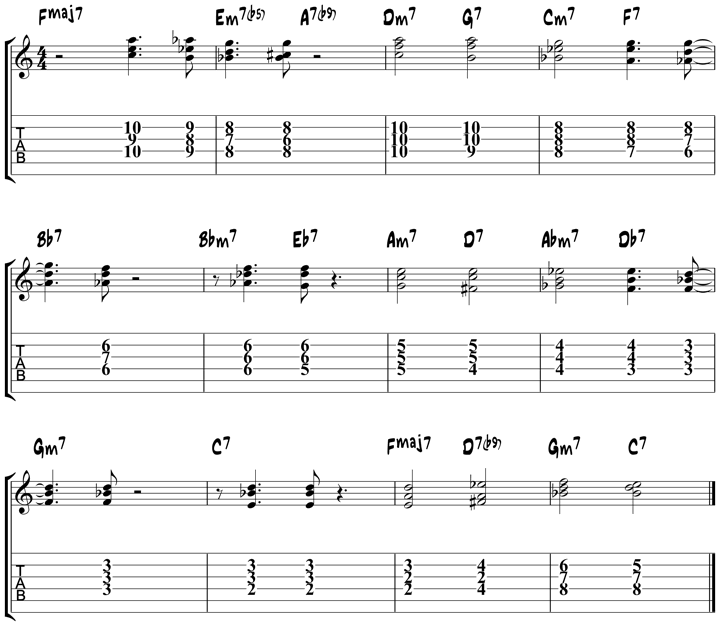
As you can see, there is a wide variety of approaches when playing the blues progression in a jazz setting. Try each of these progressions and find your own favorites to pursue further, and get the others under your fingers in case they come up in a jam.
Comping Study for a Blues in G
Here’s a more advanced comping exercise, this time for a jazz blues in G.
This exercise features chord substitutions, chromatic movement, and chord licks.
Backing Track
Listen & Play Along

Download the pdf here for easy printing.
Here is some clarification for certain chord choices made in the study:
- Bar 5-6: there’s some contrary motion going on here. The bass goes from c to c# (upward motion), while the d of C9 goes to the c# (downward motion) of C#°7. Contrary motion in voice leading sounds nice.
- Bar 8: B°7 is the same chord as E7(b9), so the voice leading goes from #9 to b9 to the 5 of Am7.
- Bar 10: Sus4 chords are a nice way to delay and bring extra motion to dominant chords.
- Bar 11: G13/F is the 3rd inversion of G13, a very useful voicing.
- Bar 11-12: the first 3 chords are on the beat, while the last 2 chords are off the beat. This brings a feeling of forward motion to the comping.
- Bar 14: this is a common Em7b5 voicing (=C9), followed by a E°7 (=C#°7).
- Bar 16: some chromatic slides going on here.
- Bar 21-22: a Wes Montgomery style chord lick.
- Bar 25: the turnaround is repeated twice as a coda. Repeating a turnaround is a common way to end jazz songs.
- Bar 30: the bass note G is played by tapping the note on the fretboard with the index finger of the right hand.
Rootless Jazz Chords for a Blues in B Flat
In this section, you’ll be looking at fun and relatively easy to build jazz blues chords that every jazz guitarist should have under their fingers at one point or another in their development, rootless jazz blues chords.
Having only 3 notes in their construction, yet still sounding the underlying chord and progression, these rootless shapes are a great way to expand your chord vocabulary and free up your fretting hand at the same time.
So, let’s get started by learning exactly what rootless jazz blues chords are and how they are built.
Rootless Jazz Blues Chords – Formulas
The first thing we’ll check out is how to build rootless jazz blues chords so that you can understand the theory behind these shapes before applying them to the fretboard.
The concept behind these blues chords is fairly straightforward: you take the normal four-note shapes for the chords of the blues progression and then drop the root. That way you only play the 3, 5, and 7 of each underlying chord.
Here is how the formula looks like when applied to the different chords in a jazz blues chord progression in Bb.
- Bb7 = Ddim (Bb D F Ab becomes D F Ab)
- Eb7 = Gdim (Eb G Bb Db becomes G Bb Db)
- Edim7 = Gdim (E G Bb Db becomes G Bb Db)
- G7b9 = Bdim (G B D F becomes B D F)
- Cm7 = Eb (C Eb G Bb becomes Eb G Bb)
- F7 = Adim (F A C Eb becomes A C Eb)
Now that you know how to build these rootless voicings, let’s take a look at an example of how to apply these chords to the fretboard.
Bb Jazz Blues Chords – Rootless Voicings
Here is how these chords would look like on the neck of the guitar, using the 4-3-2 string set as a starting point for practicing these shapes.
Since Eb7 and Edim use the same shape I have only included one of those in this example. Just know that the root note will change from Eb to E, but you can keep the same Gdim shape underneath that root to sound both chords. Pretty cool right!

To get started, try playing the root-based chord followed by the rootless chord for each of these jazz blues chords in Bb.
Notice how they sound very similar, but the rootless voicings are a little “lighter” sounding.
They are also easier on your fretting hand when shifting from one shape to the next, as they use fewer notes and smaller barres in their construction.
Bb Jazz Blues Chords – Rootless Chord Study
To help you get started with applying these rootless jazz blues chords to the guitar, here is an etude for you to learn.
Start by learning this etude as written, then start to alter the rhythms to make it more of your own.
Finally, take these shapes to other keys around the neck as you work rootless jazz blues chords further in your jazz guitar practice routine.
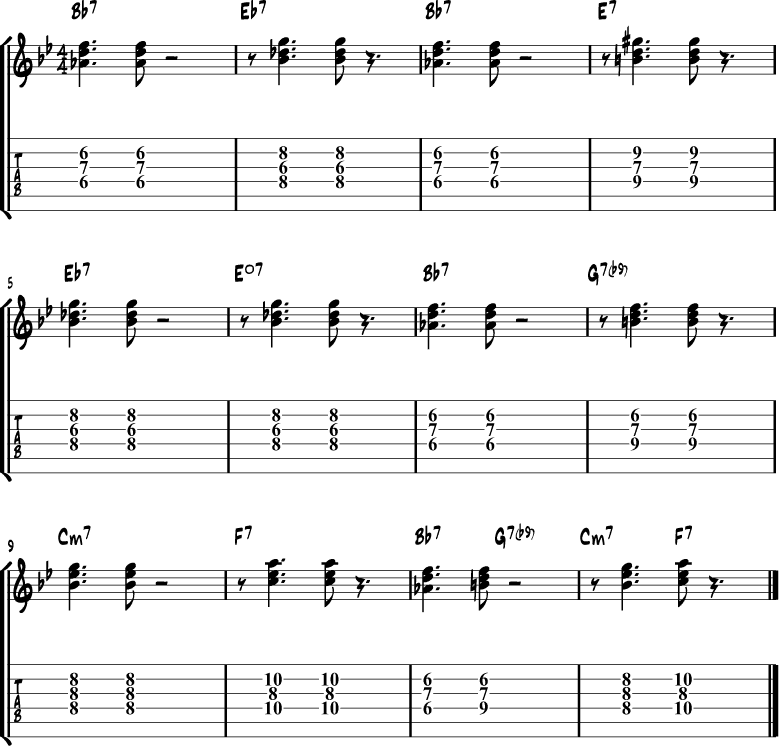
Tenor Madness Chord Melody
In this section, you will learn how to combine the blues chord progression with a melody.
Guitarists love to jam on jazz blues tunes, they’re some of the most commonly called jam tunes and often sit well on the guitar. But, while many of us love to play jazz blues tunes, we often learn single-note melodies and move on from there.
While you may think that chord melodies are more suited for other jazz standards, that doesn’t have to be the case. Jazz blues tunes can work well as chord melody arrangements, you just have to pick the right blues, and put it in the right fretboard position to make it work.
In this lesson, you learn how to play a chord melody to the jazz blues tune Tenor Madness.
Tenor Madness was released in 1956 as the title track of Sonny Rollins’ album Tenor Madness and is the only known recording of Sonny Rollins and John Coltrane playing together.
This section gives you a chord melody to play over a jazz blues at your next jam session, and you learn about chords and harmony at the same time.
Tenor Madness Chord Melody
If you’re wondering about the chord shapes in this arrangement, they’re mostly drop 2 chords with a few 4th voicings thrown in for good measure.
Drop 2 chords are great for chord melody arrangements in a band setting, as they outline the changes and stay out of the way of the bassist at the same time.
Backing Track
Listen & Play Along
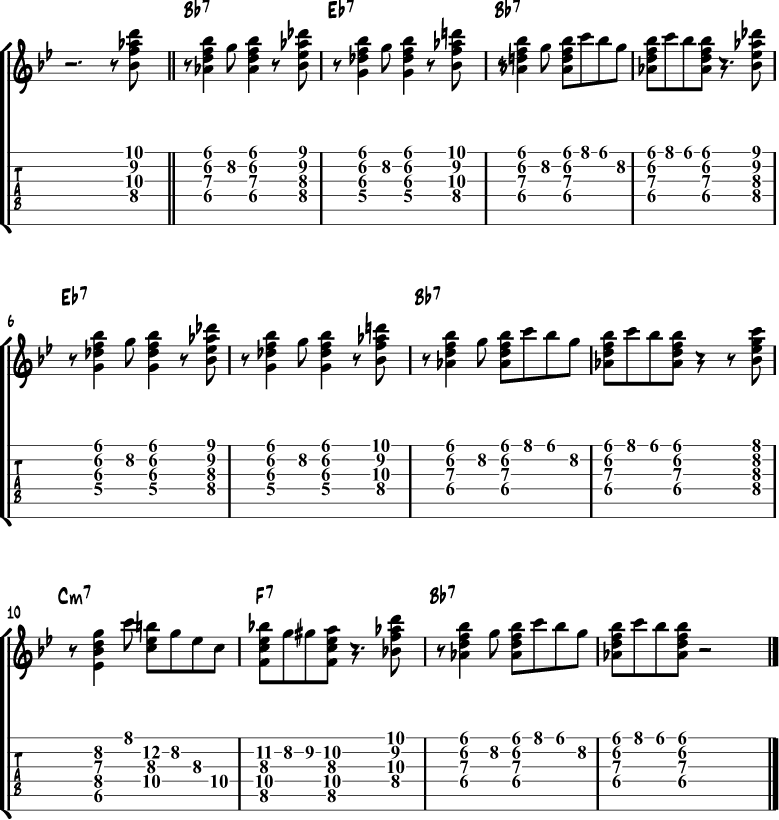
Blues Chord Study in the Style of Lenny Breau
Lenny Breau was one of the all-time great jazz guitarists. His ability to solo with single-notes and chords, play high-level chord melodies as well as adapt his playing to solo, duo, trio and larger group playing made Lenny a legend in the industry.
While there are many aspects of Lenny’s playing that you can break down and work on in the practice room, one of the most important is Lenny’s two-note comping technique.
Though it may seem obvious in hindsight, by breaking down any chord to the 3rd and 7th, and then adding color tones on top of those two notes, Lenny created a unique comping voice that is as easily recognizable today as it was back in the ‘60s when he first hit the scene and began turning heads in the jazz guitar world.
In this lesson, you’ll learn how to play 3rd and 7th chords over an F blues on the guitar, as well as learn a full chorus of F blues that mixes these two-note chords with melody notes to bring a cool-sounding jazz blues into your vocabulary.
Lenny Breau Two Note Chords
Before we dive into the blues in F chord study, let’s take a look at the two-note chords, how they’re built and how they look on the fretboard. This way you can have an understanding of the building blocks of this lesson, which focusses on the 3rd and 4th string set.
The 3 and 7 are the two most important notes of any chord you are playing in a jazz context. The 3 tells you if the chord is major or minor. From there, the 7th tells you if the chord is a major, dominant, or minor.
These two notes are enough to outline the chord changes to any jazz tune, which leaves two to three fretting-hand fingers open to add other chord tones on top of those notes or full melody lines as in the chord study in the example below.
When playing these two notes on the fretboard, you can use your fingers, or a pick and fingers for each two-note shape.
If you use your fingers, play the lowest note with your thumb and highest note with your index finger.
If you use a pick, play the lowest note with your pick and the highest note with your middle finger.
To help you get the lower two notes (the 3 and 7 of each chord) under your fingers, here are those notes over an F blues without the melody line on top.
Work on these shapes until you can play them from memory with the audio track, then move on to the full blues in F chord study in the next section of this lesson.
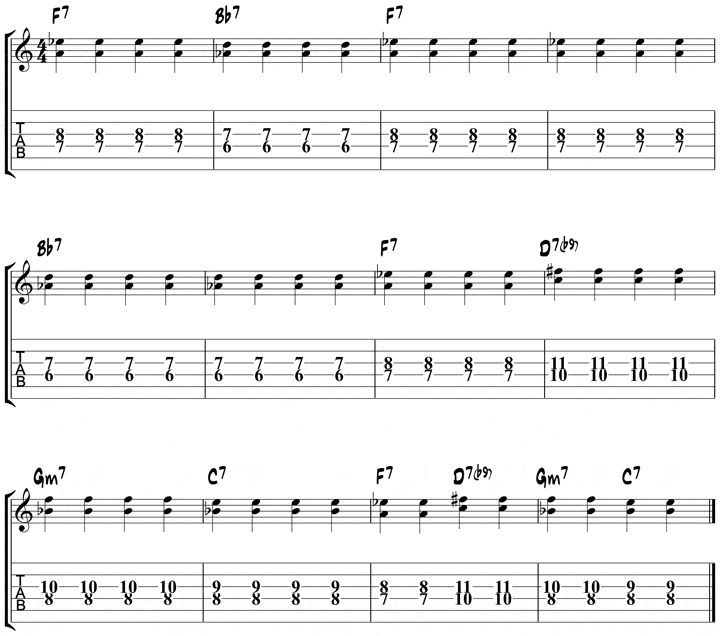
Blues in F Chord Study
Now that you have explored the background behind two-note chord voicings, you are now ready to work on the full blues in F study.
Keep the same picking technique that you used in the previous example.
If you use your fingers, play the 3 and 7 with your thumb and index finger. Play the upper notes with the other fingers of your picking hand.
If you use a pick, play the lowest two notes with your pick and middle finger. Play the upper melody line with the other fingers in your picking hand.
Backing Track
Listen & Play Along
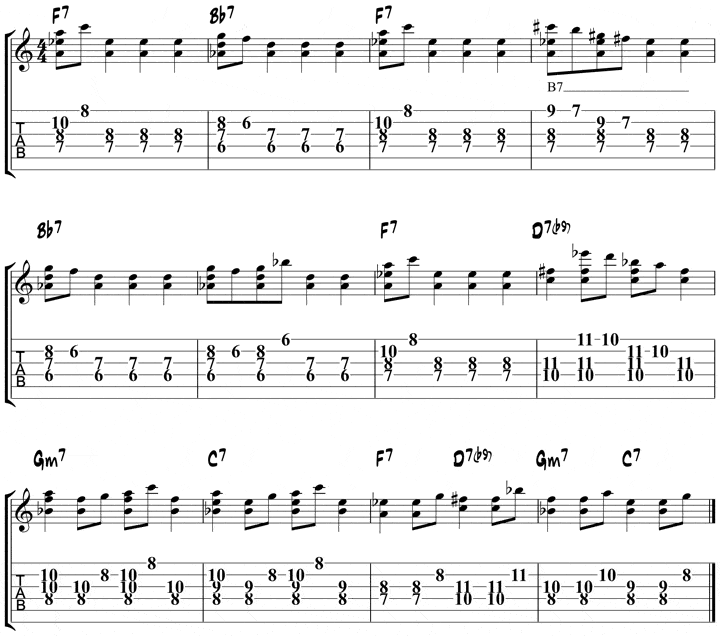
Gypsy Jazz Blues Guitar (by Yaakov Hoter)
In this part of our blues lesson, you will learn how to play the jazz blues chord progression in the gypsy style. We will also have a look at what the best sounding substitutes for the I-VI-II-V progression of the turnaround are.
Introduction to Gypsy Jazz Blues Guitar Video
The Basic Blues Progression [Starting at 1:49 in the video]
Here’s the basic blues chord progression (in the key of G), together with the chord voicings and scales we are going to use:
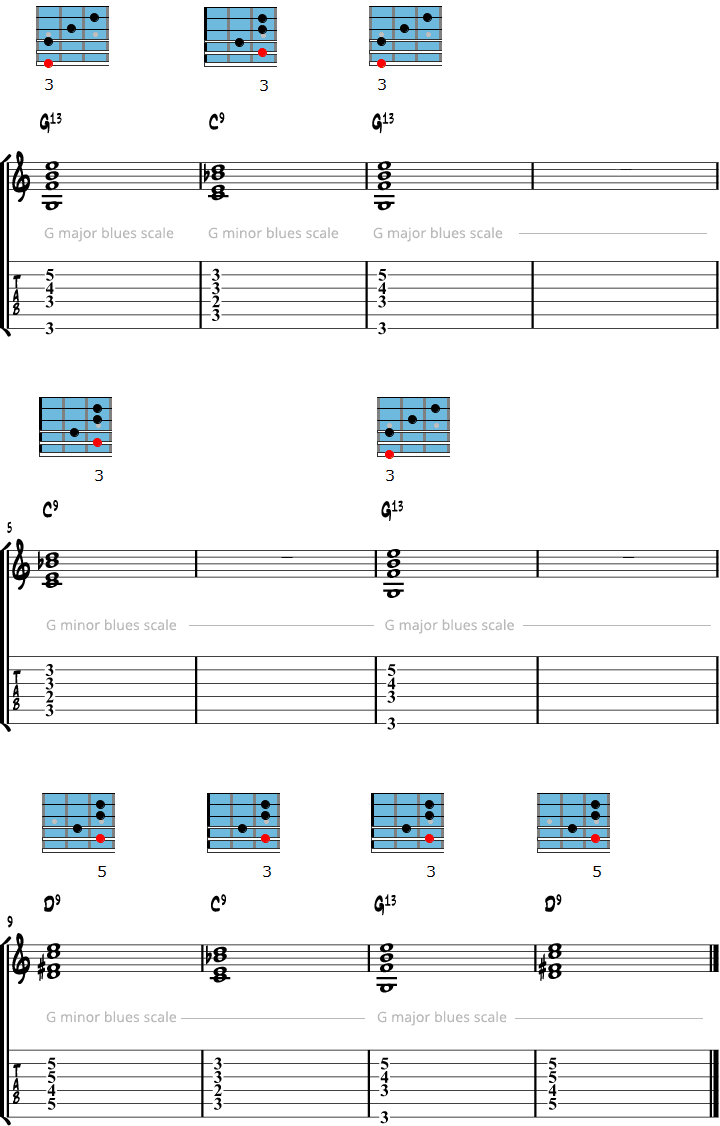
To give each chord its own sound, we’ll start with two blues scales, the G major blues scale (to play over the G13) and the G minor blues scale (to play over C9 and D9).
The G Major Blues Scale [3:56 in the video]
The G major blues scale has the same notes as the G major pentatonic scale, but with an added blue note. This blue note is the b3 of the scale (Bb in G):
| G Major Blues Scale | G | A | Bb | B | D | E |
|---|---|---|---|---|---|---|
| 1 | 2 | b3 | 3 | 5 | 6 |
Here’s the scale diagram of the G major blues scale with the root on the 6th string:
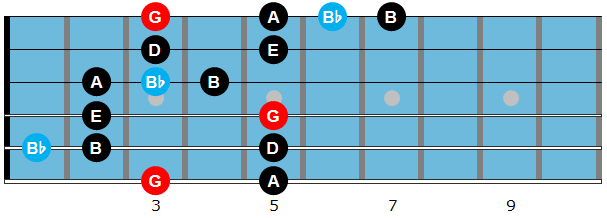
The G Minor Blues Scale
The G minor blues scale has the same notes as the G minor pentatonic scale, but with an added blue note. The blue note for the minor scale is different compared to the major scale blue note, it is the b5 of the scale (Db in G):
| G Minor Blues Scale | G | Bb | C | Db | D | F |
|---|---|---|---|---|---|---|
| 1 | b3 | 4 | b5 | 5 | b7 |
Here’s the scale diagram for the G minor blues scale with the root on the 6th string:
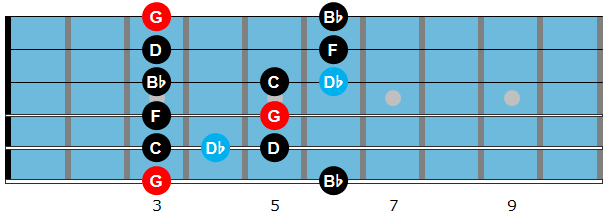
The Gypsy Blues Progression [Starting at 8:08 in the video]
Next, we’ll move away from the basic blues progression and add some variation. This is the blues chord progression that is commonly used in gypsy jazz (in the key of C):

The Turnaround (I-vi-ii-V) and Its Substitutes [Starting at 10:19 in the video]
You might have noticed that the turnaround chord progression (the last 4 bars of the previous blues progression) doesn’t sound very bluesy. To remedy that, we’ll have a look at some common chord substitutions for the I-vi-ii-V turnaround progression.
Substitute #1 – The Secondary Dominant [11:10 in the video]
The secondary dominant is a dominant chord that leads into any chord in the song other than the 1st degree.
The primary dominant of a blues in C is G7, which you’ll find in bars 10 and 12. The secondary dominant is a dominant chord that leads to any other degree in the scale. You will always find the secondary dominant on the 5th degree of the chord you want to lead to.
In the following example we replace:
- Am7 with A7: A7 is a secondary dominant chord that will lead to the target chord Dm7 (A is the 5th degree of D).
- Dm7 with D7: D7 is the secondary dominant chord of G7 (D is the 5th degree of G).
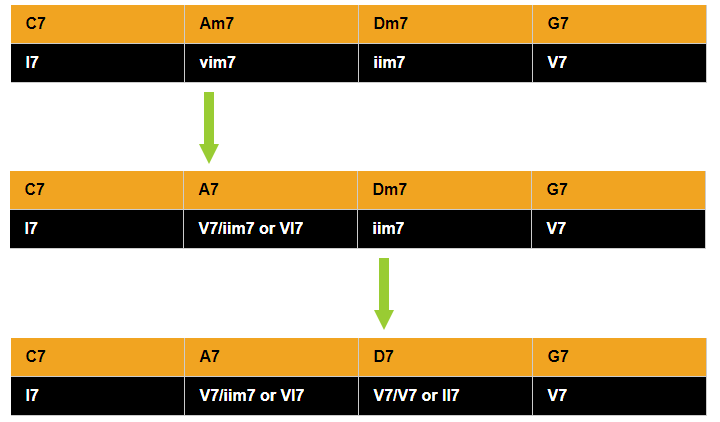
If you’re not familiar with the roman notation of chords, check out our chord analysis tutorial, it’s an essential skill if you’re serious about playing jazz.
Substitute #2 – Tritone Substitution [12:54 in the video]
Tritone substitution (aka sub 5 or substitute dominant) is replacing a dominant chord with another dominant chord a tritone (three whole steps) away from the original dominant chord.
That means we can replace any dominant 7 chord with another dominant 7 chord, a tritone above or below it.
In roman numerals, tritone substitutions can either be notated as bII7 or as subV.
In the following example we:
- First replace the A7 chord with its sub5 Eb7.
- In the second step we replace G7 with its sub5 Db7
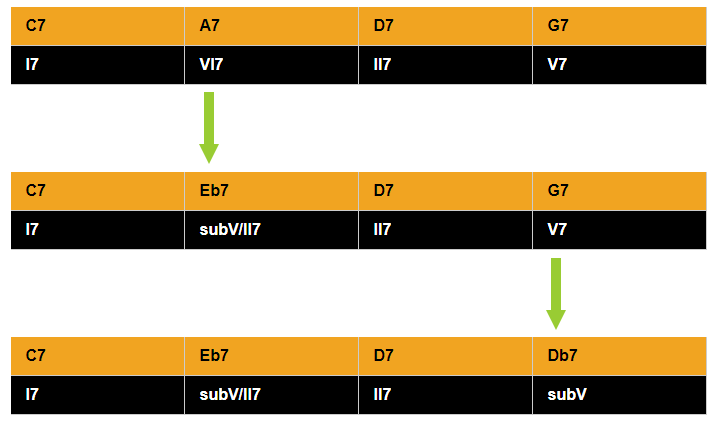
In the next example with create a descending chromatic chord progression:
- We replace the D7 with its sub5 Ab7.
- Then we replace C7 with the secondary dominant E7 of target chord A7.
- Which in the next step will be replaced with its sub5 Bb7
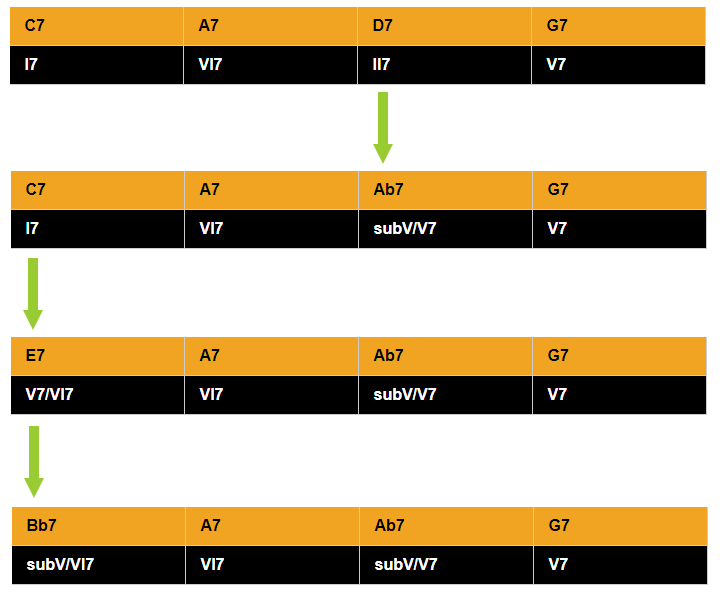

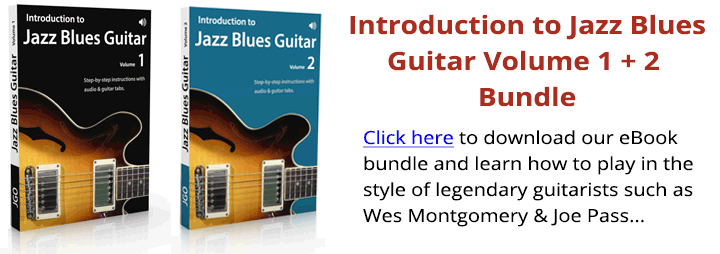


Some things are hard to understand
say in the second lesson itself
where you introduced IV7 and VI7
the notes have 9th note 7888 on 4321 strings
but the chord is 7th
Why in Tritone Substitution Blues in bar 6 the iim7 is Bm?
thank you very much for this article!
one silly question: where can I find a simple explanation for chords sequence in bars 6-7-8 in Bird Blues Changes?
not completely clear the presence of Eb7 in bar 6 and of ABm7 and Bb7 in bar 8!
THANKS
Thank you for the material, the appearance is very clear and intelligible! It is worth noting that in the 12th bar often appears a dominant chord , that corresponds to acceleration of harmonic rhythm doubly every four bars.
Isn’t it better to consider the chords in a blues as tonic sevenths? The only true dominants are bar 4, bars 9 and 10 (in varying configurations) and during the turnaround. These are the places to pile on the tension to shape the progression. These are the places to wean all those blues players away fom the prison of the blues box!
No room here to explain in details, but just this. One can add notes to a chord (1) for ornamentation-coloration or (2) to support harmonic function (=horizontal movement, drive, tension/resolution). The seventh as a blue note is a little sharper than a minor 7 but lower than a major 7, it’s intended use is (1), embellishing the sound. One should not think of the seventh chord on the tonic as a dominant 7, but as a root triad colored by a blue note, so not requiring any resolution. 2 of the 3 common blue notes can only be played on guitar by bending the string.
But, as I said, Bars 4, 9 & 10 and the turnaround contain true functioning dominants – i.e. resolving to the IV or I chords – not just coloured triads as I agree the other “sevenths” are.
In diatonic harmony/scale, the tonic degree always renders a major seventh chord! The dominant chord is derived from the fifth degree of the scale, and the fourth degree also renders a major seventh chord. The thing to take note of is, Blues progressions are not diatonic, they’re parallel progressions! So some of the rules about diatonic harmony get left by the way side…perhaps you can ask Matt to expound on the topic, or even look it up in Wikipedia, but it’s too lengthy to explain in this comment box. The guys who came up with these progressions were masters of their craft, had above average pitch recognition, if not perfect pitch and were able to play with and bend the rules that were known during their time!
We are the lake shore band and I approve your book! Great balls and fire, Greg
This’d cool even am not getting the theory I mean the staff notation am trying with the tabs supplied along big thanks
Would you mind giving some examples of the tri tone blues. Thanks. Love the history lesson
Excellent article. I love comping like this. It’s the guitarist’s equivalent to a bassist playing a walking bass line. Except for a very few cases, vocalists and harp players will love you if you play this stuff behind them.
Nice article! I would offer the example of King Oliver’s Creole band playing ‘Dipper mouth Blues’ in 1923 which does provide some question over when the chord II in bar 9 came about. https://youtu.be/BEF9QeHxrYw?t=38s
Forgive my ignorance, I just know there’s going to be a good answer to this but why does the F augmented 9th (F7#9) and the E augmented 9th in bar 7, have sharp 5th when my chord encyclopedia states the respective 5ths are natural in these chords? Hopefully someone can enlighten me, as my jazz theory is in its infancy.
Nice tune, and great playing as always.
PS does the digital process knock the backing track off pitch for anyone else? I have a boss tuner as well as the in-built tuner in my Yamaha amp and they’re in sync.
When I use the backing track we are not in tune.
In harmony the word augmented is usually used to refer to the fifth degree of the chord, the other chord degrees are usually referred to as being sharped or flatted. So when you see F7#9 it’s usually expressed as F seven sharp nine, but when you see F+7#9 or F7aug#9, it’s expressed as F seven sharp five sharp nine, which can also be written as F7#5#9 depending on your choice of nomenclature…tu sabe?
PS
About your tunings, you might want to try playing the recorded track from the beginning one note at a time, especially the bass notes and have your tuner close enough to the speakers while watching to see what notes register on your tuner. Then double check the tuning on your guitar, either re-tune your guitar or calibrate your tuner so everything is in sync!
Have always wanted to learn to comp in a Barney Kessell or should I say a “pianistic” style but could not figure how was done. Rootless voicing may be the key. Thanks again Matt for your help. You teach in a way I can understand.
Great piece of work, Dirk, many thanks. Backing track and playing example are great, from a teaching perspective perhaps add a slow accompaniment track? But excellent, thank you so much.
Bar 21 to Bar 25 of the comping study in G is wonderful chord progression. In a certain way it reminds me a bit of John Pizzarelli’s jazz comping style. Thank you very much.
Great work as usual thank s a lot
Thank you for making this available. Can’t wait to try it out:-)
Tenor Madness is one of my favorites! Played this a lot back in my Tenor Sax playing days. It’s a different animal on the guitar, maybe even more fun though. Thanks for posting it guys, it brought back a lot of great memories.
Thanks
Very nice. Thank you.
Thanks for posting this, Dirk. There’s a lot of good information here!
Nicely done, very effective and actually quite easy to finger once you recognise the shapes. Agree with Jerry above re final chord, the tab and chord name match what’s played, but treble clef notes are a semitone flat. (And at the risk of seeming pedantic, the F7 and E7 chords in bars 8-9 both have #5 as melody note, as well as #9 underneath.)
As others have said, a very good lesson, thank you.
Great lesson, Matt! Do you have some favorite rootless voicings you could share in a future lesson? Maybe demonstrate over a Jazz standard or two or three? Thanks!
Thanks, yeah check this list of lessons out. Look for the chord study or comping study lessons, lots there to explore.
https://www.jazzguitar.be/blog/category/guitar-chords/
Boy. This is a great comping lesson. Do you have anymore like these that go through tunes?
That’s beautiful.
Thank you so much for that nice progression & all your work.
Love this site.
wow dirk great lesson indeed my friend !
Nice ‘happy birthday’ quote at measure 21 of the G comping study.
Great comping Dirk, please more! Thanks a lot!
Dirk,
Thank you for this piece. I’m pretty new to Jazz and this exercise is perfect in helping me get a feel for the style. Really enjoyed working thru it and really made my day when I got it right all the way thru. Minor accomplishment for some, major hurdle here. Where can I find more compositions like this to work with? Most of what I’m seeing is either short 1 or 2 measure riff exercises or long full blown pieces that are a bit much for someone at my level to absorb, remember and understand.
Again, thanks.
Al B.
Thank you for this im becoming better.
How did you name this beautiful piece? It deserves a title.
Just started grinding into it. Can’t wait to get it good at it, guess I’ll just have to dive right in. Thanks a bunch!
I had learned a little bit of this from a Danny Gatton CD. He mentioned that Lenny Breau was an influence. This is a good expansion of it for me. When I first heard these two note type chords I thought there was more to it trying more complicated chords. The 3rd and 7th fill in so simply and yet give a real great Jazz feel to the progressions.
Thanks
Thanks its very good for practice
Great stuff
thanks so much , when I listen to the track and to the backing track it is very useful for my ear training , I need such lesson for Blues which has been always difficult for me to learn but now I am trying to and this lesson is helping me .
Hi Matt, Thanks again for your always valuable lessons and etudes.
A quick question : what is your recommendation for left hand fingering ? F7 for example : A (1) and bE (2) or A (2) and bE (3) ?
Thanks
Pierre
I use 1 and 2 but Lenny also used 2 and 3 so try both and see what fits best.
The lessons are all great to study jazz guitar.
The teachers are great!
Thanks, Matt. Nice lesson. Do you use barre throughout ?
Hey, yes I use a lot of barres in this study.
the book
Long Tune, One Winnipeg Free Press (MB), May 28, 2006
The Life and Music of Lenny Breau
This is another lesson to my level I Appreci much. Continue as ç and the way that we can do together will be more trainer.
Thank you again.
Hi Dirk & Matt
great stuff by Lenny Breau, more please !
it’s a pity “the man in the street ” new little
of this genius.
very nice and useful ! thanks a lot …
Hi dirk
Nice to make youre acquaintance
You dont by chance cultivated or teach
I m a guitarist and vocalist
Looking to join a band of calibre of substance
Thanks ridge
Superb lesson yeah: that’s what’s all about!! For shure in a Big Band!!
Lenny was/is one of the best,a true legend!! Thanks … more,more!!??
Thanks a lot…easier ,interesting
luciano
Thanks Dirk,
Very interesting and important. I like your blog very much. Congratulations. I did not know that Lenny Breau was the initiator of “guide tones”. Could Dave give the references of the book “One long Tune”?
Hi,
very nice indeed!!
Thanks,
Roberto
I definitely will start on this tomorrow. It looks deceptively simple but I sense a real challenge for a newbie!
Very nice study and easier and fun to play. Makes a great addition to the standard blues sound
Excelent class!!!
too bad he got murdered his music is a study that has rewards you memorize it.
As an occasional student of Lenny’s when he was still with us, I can say you have covered his comping basics nicely. He had such a complete understanding and abiltiy as a guitarist and overall musician. One thing he had me work on was playing 7th arpeggios across and up the neck in 4ths (Ex Cmaj7, Fmaj7, B07, Em7). Replicating this pattern up the next in the same key adds a nice flavor to my improvising. He also had some classic lines/phrases that can be used liberally(ex. minors aloud head)and bop lines.
Check out the book on his life, `One Long Tune,’ if you have not yet done so.
In addition to his history, theer are some musical insights within.
Thanks for your continued efforts
Dave
Hey Rick; Was working this out on Lennie’s 1965 Epiphone Texan. Ran into him in 1966 when he was trying to get clean and traded a 1955 Chevy Bel Air 4 door hardtop, Robin Egg Blue for the guitar. He had no license, no insurance, said he’d write but never heard from him. Tragic, such a talent. A luthier friend of mine, first time he saw the guitar, said he’d played it at the Horseshoe Tavern one night.Had a scratch on the top he remembered. Said he gave Lennie shit for being so careless with his instruments. Said he’d pawn them, too, at the drop of a hat, if he got desperate. His tech Rufus Stewart refitted it with Grover Deluxes, a bone nut and a high density Rosewood saddle with bone bridge. I’ve turned down so many offers over the years. It’s a killer, sustain that goes on for days and a tone that would make an MMA fighter cry. Bend the blues right into the next world. A freak piece of wood. My now deceased pal said it sounds like Lennie had innoculated it with his hurtin’ soul…. cheers
wow
i know what you’re saying i can play, i just cant teach, and i dont know much about masciul theory but i play from the heart, you know.anyhow, last week a nice girl that lives a few houses away stoped by and asked me if i could teachefbbbf her guitar, people arround the neighborhood often hear me play at night so that how she found out.anyway after 2 days of teaching her, i told her i couldnt do it.i felt devastated for the entire week.
Dirk, this was a fantastically useful lesson for helping to develop a better understanding of voicings, chord leading, and passing chords. Lessons like this where you can easily take these and apply them in many other situations are just fantastic. Keep up the good work!
Great blues lesson Dirk! My students will love it, especially the chord voicings.
wiz
Super! Thanks!
Wow, this is a great lesson. The pdfs on my music stand outweigh my guitar and will soon approach the weight of my amp! But it’s all so good…..
This track sounds more like an Ellington-type blues than a B.B. King blues, so I’m thinking the minor pentatonic scale would not be “enough.” Am I right or can it work?
you can work on the whole 12 bar jazz blues with the tonic minor pentatonic, sometimes major pentatonic, the blue notes fit almost anywhere and the major 7th is a nice note to play instead of the 7th on the I7.
Hey Dirk,
I’m jsut starting to learn blues and many of the websites I’ve seen emphasize using either the minor pentatonic scale or the “blues” scale for solos. Looking at this track, would either of those scales work or is something more elaborate needed?
Thanks for new inspirations.
Super lesson thanks.
Thanks for sharing this wonderful lesson. It’s a little beyond me, but that’s the fun! I WILL get there.
Thanks for the great lesson, Dirk! When you can, would you please share how to play the blues scale as 4-note jazz chords? We’ve all seen articles showing the major (and sometimes various minor) scales in the form of the 4-note jazz chords diatonic to the scale. What are the blues scales (major and minor) in the form of 4-note jazz chords?
what chords has measure 10 ?
Can you explain, Dirk?
Forgot to put the chord symbols there…
The first voicing is a C triad over a D in the bass, which sounds like a D9sus4. The second voicing moves the 4 to a 3, which sounds like D9…
Working on the pdf…
Please explain measure 10 of the G blues comping study. Love the sound of the IV/V D11 but how is the next chord a D9? (maybe I haven’t got far enough in your jazz blues book :))
Dirk, this is a great lesson, i will try to play on a mandolin. thanks.
I have a long way to go Dirk but it’s lessons like this that motivate me to keep going! Many thanks for sharing your skills and knowledge.
You’re welcome Rob!
I’m enjoying the e-lessons, and plan to subcribe to the entire series. Have you thought of customizing the lessons, for example, I’m a Smooth Jazz fan, into people like Norman Brown, Ronny Jordan, Paul Jackson, Jr., Jeff Golub, and Chuck Loeb to name a few. There is hardly any Smooth Jazz lessons on the web. Is it possible to customize lessons in this or any other Jazz style?
Hi Dale, that’s a good idea!
Did you check Chris Standring’s course? He’s into smooth jazz…
https://www.jazzguitar.be/recommends/play-what-you-hear.php
Great lesson Dirk. I always pick up something new from these. Great job.
Thanks Marty.
Great lesson Matt. I’ve passed this on to a friend of mine that was asking rootless chords last night. The only thing I would have liked to see added is a discussion of substituting the 5 for the 1 in some of these voicings ala Freddie Green. But excellent nonetheless.
Thanks, yeah there are a ton of ways to work these rootless chords, I’ll be expanding upon these ideas in future lessons with 9ths, 5ths, etc. Fun stuff!
Matt, I said it before, I will say it again, I play keyboard, but have always learned more from guitarist, the unique way for chord structure,harmonically, and melodically is beautiful and so different from what keyboard players do, I learn more every time I open up a new lesson, Thanks
Funny you should say that, Jeff. I listen and learn from piano players for great harmony ideas.